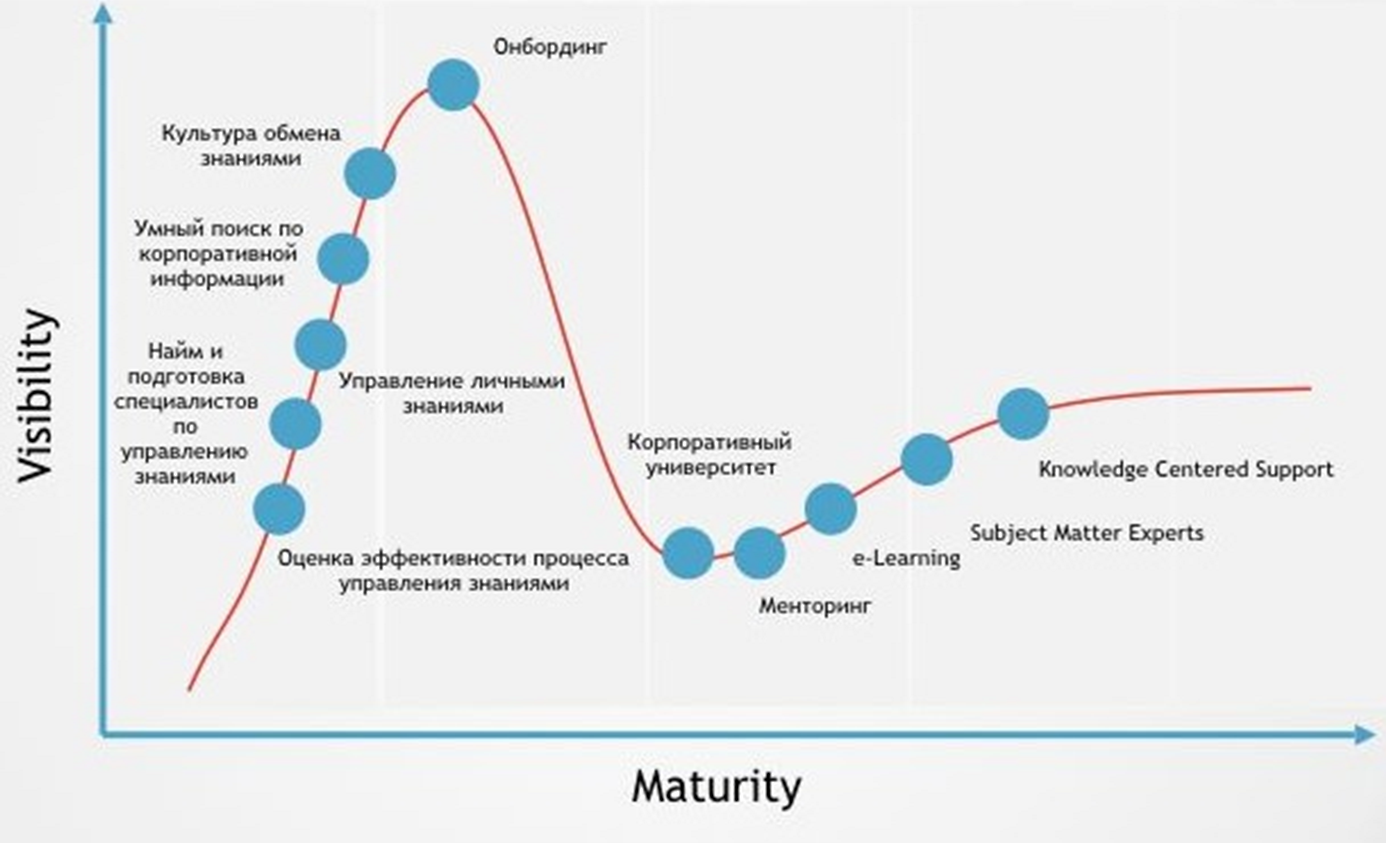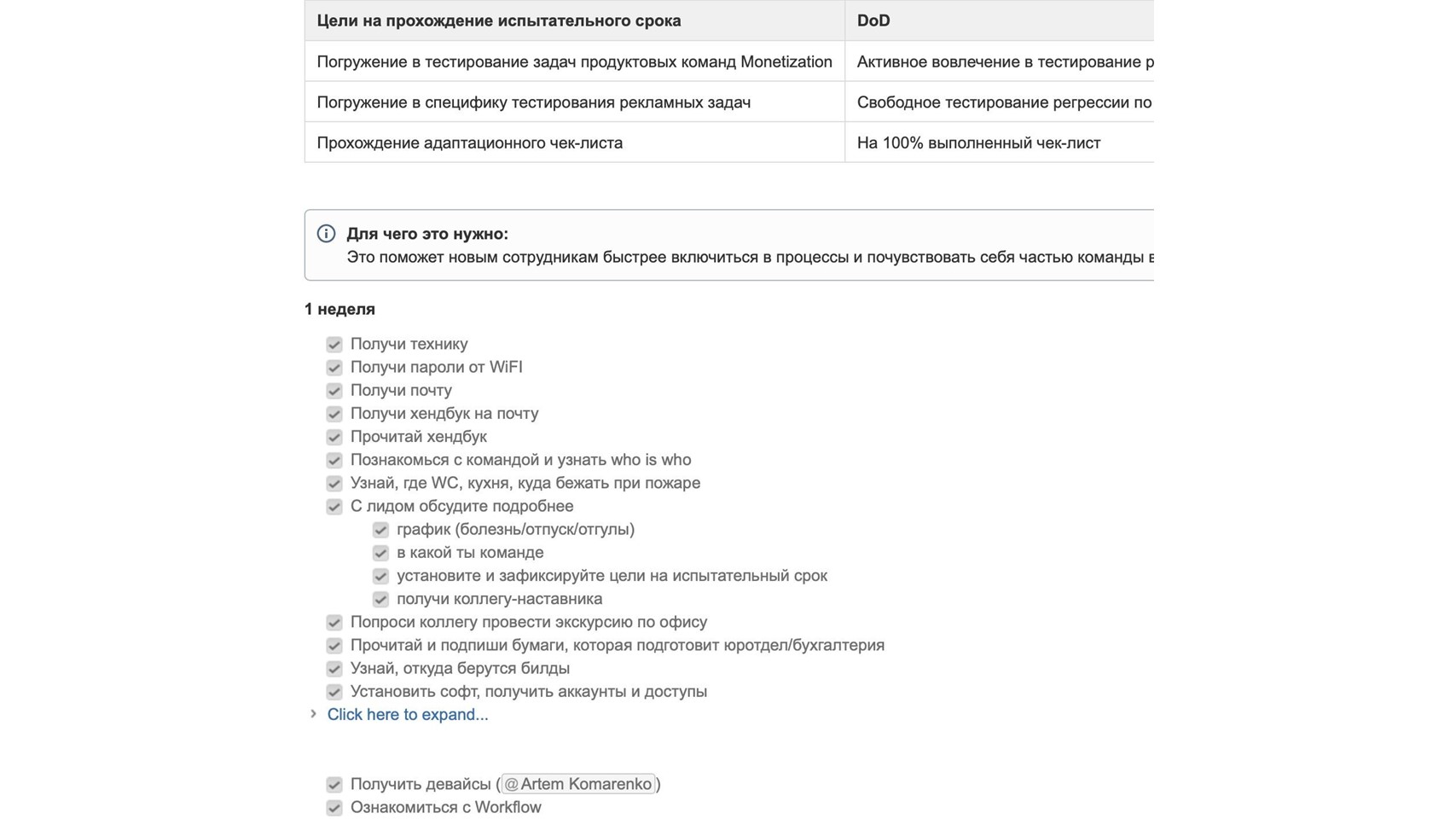Adaptation checklist as a soft entry tool
A new employee in a company is stressful for both a novice and a company. For him, everything around him is unfamiliar: office, product, team, technological stack, processes. All this needs to be adapted and sorted out quickly so as not to torture others.The adaptation process can be left to chance. Given the costs of the HR department, department head, team lead and other employees to find suitable personnel, this is an ineffective approach. When a beginner understands that no one helps him to join the team, he will simply leave on a trial period. If it remains, the adaptation will take too much time; nobody controls it. Therefore, the adaptation process is important to configure. A well-functioning system saves time and resources of the company and employees, allows you to introduce a newcomer to the course of affairs as quickly as possible and begin to get results from him.An adaptive checklist will help you set up the system. It contains the key aspects of adaptation at different stages of the introduction to the post: adaptation zones, what skills and in what sequence should a beginner learn, a mentoring system, certification and feedback. More about what a check list is and how it works, tell Alexey Petrov (pifagor_mc)Alexey - Head of QA department FunCorp, conference speaker, author of testing courses. In IT since 2005, he has been managing since 2010. He has gone from a junior tester to a quality director.
Therefore, the adaptation process is important to configure. A well-functioning system saves time and resources of the company and employees, allows you to introduce a newcomer to the course of affairs as quickly as possible and begin to get results from him.An adaptive checklist will help you set up the system. It contains the key aspects of adaptation at different stages of the introduction to the post: adaptation zones, what skills and in what sequence should a beginner learn, a mentoring system, certification and feedback. More about what a check list is and how it works, tell Alexey Petrov (pifagor_mc)Alexey - Head of QA department FunCorp, conference speaker, author of testing courses. In IT since 2005, he has been managing since 2010. He has gone from a junior tester to a quality director.And again he, onboarding
As the Head of QA department, I regularly hire people, and the question of adapting them regularly also arises. But this question is being asked not only by me, but also by other companies when it is necessary to move a new employee to the current reality. The issue of onboarding is now in the wake of popularity. Why it happens?
Why it happens?Finding IT professionals is difficult.
This is due to the demographic situation, great competition, high demand for specialists and their cost, with the outflow of people to other countries.All these reasons delay the search for specialists. A recruiter or HR spends several months hiring : proofreading HeadHunter, LinkedIn, My Circle, invitations and interviews. But this situation is not catastrophic. A catastrophe is to lose a person when they finally found him: he went to work and after 2 weeks left due to stress.I have repeatedly been onboarding in different companies. Once he came to a directorial position in the Mail.ru holding. As part of onboarding, for some reason I was introduced to two ordinary developers, and a month later they both left the company. Then they were afraid to introduce me to someone else.In large companies, adaptation is usually carried out by an entire unit in the HR structure, and in smaller companies, unit heads and team leaders. As a leader, I also participated in this, but the process did not suit me. I began to wonder: “How to structure and organize the adaptation of an employee?”What is usually adapted? In basic things: people, household issues, a product and its market, processes, architecture, company, regulations, traditions, tools. But a novice is rarely adapted on all counts, and more often than not, everything goes according to one of four classic scenarios.Typical adaptation
Huge unreadable document or folder . This is a long monolithic footcloth in which all the documents from the beginning of time to the current moment are collected. Another option is an FTP folder with a knowledge base. All this is given parting words: "Read!"Where to start, where to finish, how to navigate this? A person is lost in a fragmented knowledge base and demotivated even more. Let me remind you that we took a high-class specialist at a price of six figures , which consists of his salary and HR man hours and other colleagues spent on hiring. As a result, the specialist rests on a footcloth. Are you seriously?List of scattered documents “on request” . This situation is even worse. For example, an employee has a question:- What is the life cycle of tasks in our tracker?
- Go to Peta, he will show you the documentation. She’s lying somewhere, you just won’t find it!
- How to book a meeting room?
- Go to Dasha
- ...?A new employee needs to ask a question, try to solve it, find a person who knows how to solve, and only after that they will give some kind of answer. Or maybe they won’t.Welcome meeting . This procedure in various forms is implemented in many companies. She was in every second company where I worked for 15 years. What does it look like? HR arrives, sometimes a direct supervisor, and in half an hour tells how the company is organized, where you can close your basic questions, whom to ask. That's all, further on.No way. Many companies do not have an adaptation procedure. Once, I came to the company as a leader, met with the team and we went together for lunch on the first working day. My immediate supervisor approached us and decided to arrange a “Welcome-meeting”. He sits down and says:- Lesha, this is your team. You are adults, then you will figure it out yourself.Five seconds and he left. On this adaptation within the company ended. Everything seems to be bad. Is it possible to solve the problem?
Everything seems to be bad. Is it possible to solve the problem?My recipe is an adaptation checklist
I have been using it for the past four years. How did he appear? We decomposed and modified the biggest monolithic footcloth: we divided it into temporary and functional blocks, downloaded additional materials of aspects that were missing, for example, review stories about a product, market or processes within a company. Additional materials were written either by themselves inside the unit, or they went to HR colleagues, to the grocery department, to developers, so that they fill niches. So this checklist was formed.We requested all documents in advanceand put them in one place - in a check list with links. It is very convenient when the company has a knowledge base. I had it Confluence: it allows you to put links, attach files, videos. Without interruption from production, the employee can familiarize himself with the full list of knowledge.We turned the first Welcome meeting into an iterative event - with regular feedback.Let's talk about the nuances of the checklist in more detail.
How did he appear? We decomposed and modified the biggest monolithic footcloth: we divided it into temporary and functional blocks, downloaded additional materials of aspects that were missing, for example, review stories about a product, market or processes within a company. Additional materials were written either by themselves inside the unit, or they went to HR colleagues, to the grocery department, to developers, so that they fill niches. So this checklist was formed.We requested all documents in advanceand put them in one place - in a check list with links. It is very convenient when the company has a knowledge base. I had it Confluence: it allows you to put links, attach files, videos. Without interruption from production, the employee can familiarize himself with the full list of knowledge.We turned the first Welcome meeting into an iterative event - with regular feedback.Let's talk about the nuances of the checklist in more detail.The cornerstones of the checklist
These are the moments that determine its structure: publicity, time blocks, understandable performance criteria, mentor and feedback.
Mentor
A mentor is attached to the checklist . This is the conductor of a new employee in the company, without him anywhere. Sometimes it happens that the mentor becomes the immediate supervisor. But when 10-15 people enter the team, the leader will spend an excessively large amount of resources on mentoring.A leader does not have to become a beginner mentor.
Mentoring does not require the competencies of the leader. Enough basic ideas about what and how the company works.If you are a leader, delegate mentoring . Find within the team empathic people who are interested in the appearance of additional people and resources and engage them. They will do better than you. For example, as in Mail.ru Group. The company has a whole institute of mentors - a separate caste with its own trainings. There the title of “mentor” is honorable.Publicity
The checklist is public . Imagine an unfortunate newcomer: he is stressed out, trying to understand what is happening, does not understand where to grow and what to do inside the company. Around him walks HR or team lead, squint and tick off in some kind of “check list”. Is it absurd? Of course, that’s why the checklist is available to both the mentor and the employee. Now at FunCorp we use practice when the checklist is public and in relation to the team.Public access increases the responsibility of a mentor and a novice . When the whole team sees the progress of a new employee and his path on the checklist, the mentor's responsibility grows by an order of magnitude.Involves the mentor and team in the passage. Here the team is not an overseer, but an assistant. If someone sees that there is no question about traditions in the checklist, one of his colleagues can say about this: “We have a tradition - every new one is put down on Fridays with beer!” Perhaps this is fiction, but so he participates in the adaptation of a new employee.This involves not only one mentor and immediate supervisor, but the whole team. This is good psychological support for a newcomer. He understands that these are not scattered people who look askance and put some ticks, but a team that supports him.Temporary blocks
Decompose and conquer . The checklist is divided into blocks: first week, second, first month, second and third. Inside the checklist, these timelines allow you to break the footcloth into a list of tasks. It will be strange if a person, within the framework of adaptation, in the first week tries to understand a complex tool that is useful only for the third month of work.On the contrary, it also works - why postpone familiarization with the restrooms in the office until the third month? Although I came across a couple of times with a situation where it was only on request. The restroom question was a secret behind seven seals: no one showed or told, at home you go to the toilet before and after work, but you endure at work, or try to find out from someone where this “office” is.Clear chronology of adaptation. A beginner goes from simple to complex: first, tradition and product, then he gets acquainted with his product team, then he gets the necessary accesses. When everything is completed, a full-fledged employee is ready who performs a certain layer of work.Definition of done
Obvious and understandable criteria for completing a task . This is important - it helps to evaluate that the item is really completed and the check mark is not checked “for the sake of a tick”.Sometimes, between a mentor and a beginner, there is a temptation to enter into a "criminal conspiracy", to mark an item on the check list without checking.- I need to familiarize myself with some regulations - I saw somewhere in Confluence a list of regulations. I probably got acquainted with them.The mentor also thinks:- Well, I got acquainted, then I got acquainted.Do not do this.During a one-on-one meeting and collecting feedback, I recommend diagonal screening on checklist items. For example, if an employee has dealt with tickets in the tracking system, ask him about key statuses. If you installed and configured the tool for work, make sure that this is true. Sifting helps to clarify the reality of the implementation of items.I do not recommend arranging checks like on an examination committee . You can reach senility: "Let's sit down and you will slowly show how you figured out the point of going to the restroom." Be softer, remember that you took not a junior, but a professional. He is aware that the checklist is a “waypoint map”. The employee understands that his own success in the company depends on honesty of execution. If he is deceiving, he will deceive himself, not the employer.One-on-one Feedback
At the end of each block, we hold one-on-one meetings to get feedback.Check the checklist - find out what points are completed . Ideally, by the end of the reporting period, all items should be completed. This is an indicator that a new member of the team received the necessary baggage of knowledge, skills and competencies.It’s also a good opportunity to talk with a person.about what he likes or dislikes in work, team and company. In my experience, when newcomers come to the company they all say that they like everything. Sometimes it’s euphoria, pink glasses, but often it’s a fear for their future fate. A man thinks that he will be fired if he says that Petya is a bad manager. Therefore, he is silent, suffers, leaves during the probationary period, and Petya remains. Only at the exit interview we learn that the newcomer did not want to work with the manager.Be sure to collect the "negative". When collecting feedback, go deeper and suggest options: “Maybe you don’t like the process or something in the office. Perhaps our orders and traditions are not satisfied? ” It is the "fresh" people in the company who have a non-smoking look. They highlight the problems that you no longer see, because you are used to it or so "historically."Provide feedback . You must do this too - indicate that the person is doing well and that is not, with what problems, how to adjust your behavior or qualifications.One-on-one Feedback on Time Blocks
Let's consider it in more detail - each time block separately.
First week. Personal assessment and goals
Two ratings . After the first week of work, provide two ratings: your personal, as your immediate supervisor, and mentor. Talk about everything you like and dislike about the process of completing the checklist and performing the initial work.To all the newcomers who come to my teams, I give a simple installation: a good newcomer will “bomb” everyone with questions.
A novice who does not ask questions, at best, does nothing, at worst - does something wrong. At this moment, I once again say that he as often as possible addresses questions to the mentor, manager and colleagues, because this will involve even more in the adaptation process.Goals . Remember the goals you need to complete in order to successfully pass the probationary period. If there are clearly defined goals and criteria for their fulfillment during the trial period , then the stress level of the new employee will be an order of magnitude lower than in a situation where he does not understand until the last day - has he passed the trial period or not?Speak goals and criteria at the first installation meetingbut not on the first day of work. On the first day, the beginner is interested in questions of the level: “Where is the dining room, where is the restroom, how to get into the tracker?”. After the beginner has caught her breath for a week, speak out the goals so that he understands where he is going, how many “levels” and “bosses” are ahead.Second week. Unit Evaluation
Feedback from the unit . You evaluate the employee and give him feedback not only from yourself personally, as a mentor or leader, but also collect material from the unit in which he works.Do not separate yourself from the collective . This is especially important. As head of the division, report news exclusively in the installation “We believe that you work well (or badly).” The approach when the leader gives his opinion and then separately mentions that the team does not think so, creates the impression that the boss is good, and someone in the team is plotting.When you will collect feedback from employees within the department, choose one of two options. In the first option, you take the side of the team - collect negative reviews along with arguments. In the second, break up the negative if you do not agree with the opinion of the team and explain why. But do not separate from the team, come to a common opinion.First month. Assessment of colleagues from other departments and movement towards goals
Evaluation from other units . It is logical to assume that in the first 2-3 weeks a person will work more within his own team on small routine operations that allow him to be involved in work within his unit. By the end of the first month it will be more tightly integrated with external teams. At this time, other teams and units will form an opinion about the new employee, which you can collect.Protect your employee’s interests. You can not contrast yourself with other teams: “We, in testing, think that you are cool, but development is not.” This creates a bad atmosphere between teams. The situation is similar to the collection of feedback within your own unit: either agree with the thesis that was brought from outside, or dispute it. Responsibility for feedback should not be divided and bordered.Goals . In the first month, you return to the goals of the probationary period and help set concrete concrete next steps for their implementation. It is at this moment that a person is as ready as possible to master the basic tools, gain access, perform standard operations, integrate into teams, meet the right people. He can begin to “light” precisely at the monthly mark.Second month. Timlid assessment of other departments, first warning
Feedback from team leads from neighboring teams . The newbie has already worked with entire groups. Most likely, the Timlids formed some idea of him. It is important to gather the opinions of team leaders about the employee and enable the person to feel that his appearance in the company is noticeable and causes a reaction: positive or negative.The second month and the meeting with feedback is the perfect moment for the "last Chinese warning . " Tell the employee about his “jambs”: “If you continue to do A, B and C and don’t start doing 1, 2, 3, then you won’t pass the probationary period.” If you talk to him correctly, at the end of the third month the person will have no questions whether he passed the probationary period or not.Transparency, which is achieved through the checklist, including, allows the employee to reduce stress at the time of adaptation.Third month. The results of the trial period and the achievement of goals
Summarizing . A beginner goes through a trial period, you sum up, talk about goals. It’s great if the goals are not stereotyped, but formulated according to SMART: specific, time-limited, measurable and relevant.Tell us about the good . As a leader, broadcast positive on behalf of the company. When a person comes to the climax of a probationary period, label it approval and positive. Tell us where the person showed himself successfully, how many and what tasks he did during the probationary period, summarize.Praise. After completing the probationary period, be sure to praise the employee. In Russian culture, this is a big problem. I get the impression that when we are all born, 3 freight trains of criticism are shipped to us, and praise is a glass. Therefore, we think - to praise or not? Spend a little praise today or save next year?How useful is a checklist?
The issue of adaptation is regulated : there is an instruction, you can walk along it and tick off. The instruction is public: a new employee, mentor and the whole team are involved in it.A checklist is a scalable and flexible tool . I am sharing it with you, you will share it within the company and the team. Most of the checklist is general: it is not tied to a specific functional unit, it does not contain nuances related to the product, processes, architecture, domestic issues and traditions. Add general points to the template and add, depending on the functional unit, whose employees thought about doing onboarding in their team.Roadmap of goals before your eyes. With her, the passage of the trial period is more comfortable. This is a clear sequence of actions - a set of 30-50 points that step by step will bring it closer to the goal. Passing points is like a game with different missions that must be completed in order to get to the Big Boss. The more accomplished, the closer the victory.The fastest entry of employees . Do not forget about the business. You spent a lot of money and resources to hire a class specialist, did not lose it and brought it to production operation indicators as quickly as possible - this is the main goal, the company is satisfied.Argument for early probation. For some newcomers, a checklist becomes a challenge. I met people who performed it ahead of schedule and went through all the points in 1.5-2 months. This is a good help in discussing the early closure of the probationary period. You can go to the manual with the document and say: “Look, we have a procedure, a regulation. It usually takes 3 months, and Dasha passed in 2. We checked, everything is fine, let's take it. "You can use the example of an adaptation checklist for a quality assurance specialist. The general structure and compilation logic are designed as in a material. For the rest, adapt to your own needs.- . . , «». , Knowledge Conf 2020.
, , — . — 18 . , — , 23 . , Telegram-, .
Source: https://habr.com/ru/post/undefined/
All Articles